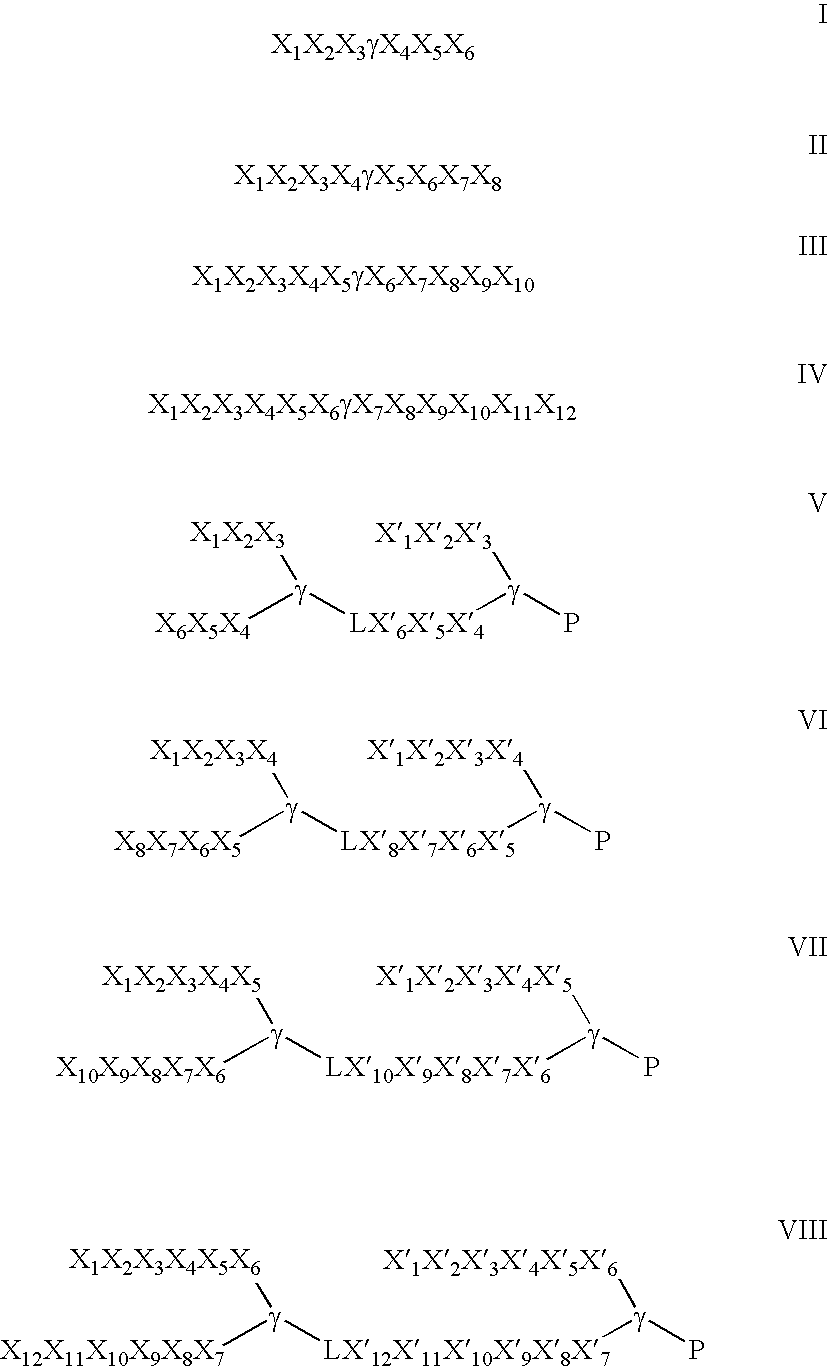Stereochemical control of the DNA binding affinity, sequence specificity, and orientation-preference of chiral hairpin polyamides in the minor groove
a chiral hairpin polyamide and dna binding technology, applied in the field of polyamides, can solve the problems of extreme difficulties in recognizing longer site sizes, the pitch of the ligand helix, and the extreme difficulty of the design of hairpin motifs, etc., to inhibit tighten the binding site, and inhibit the effect of expression of the requisite gen
- Summary
- Abstract
- Description
- Claims
- Application Information
AI Technical Summary
Benefits of technology
Problems solved by technology
Method used
Image
Examples
example 1
Synthesis of Improved Polyamides
[0061]Two polyamide-resins ImPyPy-(R)Fmocγ-PyPyPy-β-Pam-resin and ImPyPy-(S)Fmocγ-PyPyPy-β-Pam-resin, were synthesized in 14 steps from Boc-β-alanine-Pam-resin (1 g resin, 0.2 mmol / g substitution) using previously described Boc-chemistry machine-assisted protocols (FIG. 4; Baird, et al. J. Am. Chem. Soc. 1996, 118, 6141). (R)- and (S)-2,4-diaminobutyric acid residues were introduced as orthogonally protected N-γ-Fmoc-N-γ-Boc derivatives (HBTU, DIEA). Fmoc protected polyamide resins ImPyPy-(R)Fmocγ-PyPyPy-β-Pam-resin and ImPyPy-(S)Fmocγ-PyPyPy-β-Pam-resin were treated with 1:4 DMF:Piperidine (22° C., 30 min.) to provide ImPyPy-(R)H2Nγ-PyPyPy-β-Pam-resin and ImPyPy-(S)H2Nγ-PyPyPy-β-Pam-resin, respectively. A single-step aminolysis of the resin ester linkage was used to cleave the polyamide from the solid support. A sample of resin (240 mg) was treated with either dimethylaminopropylamine (55° C., 18 h) to provide 1-R, 1-S, 3-R, and 3-S or ethanolamine (...
example 2
Binding Site Size and Location by MPE•Fe(II) Footprinting
A. Preparation of 3′- and 5′-End-Labeled Restriction Fragments
[0081]The plasmid pMM5 was linearized with EcoRI and BsrBI, then treated with the Sequenase enzyme, deoxyadenosine 5′-[γ-32P]triphosphate and thymidine 5′-[γ32P]triphosphate for 3′ labeling. Alternatively, pMM5 was linearized with EcoRI, treated with calf alkaline phosphatase, and then 5′ labeled with T4 polynucleotide kinase and deoxyadenosine 5′-[γ32P]triphosphate. The 5′ labeled fragment was then digested with BsrBI. The labeled fragment (3′ or 5′) was loaded onto a 6% non-denaturing polyacrylamide gel, and the desired 135 base pair band was visualized by autoradiography and isolated. Chemical sequencing reactions were performed according to published methods (Iverson, et al. Nucl. Acids Res. 1987, 15, 7823; Maxam, et al. Methods Enzymol. 1980, 65, 499).
B. MPE•Fe(II) Footprinting
[0082]All reactions were carried out in a volume of 40 μL. A polyamide stock solution...
example 3
Binding Orientation Determination by Affinity Cleaving
[0084]Affinity cleavage experiments (Taylor, et al. Tetrahedron 1984, 40, 457; Dervan, P. B. Science 1986, 232, 464) using hairpin polyamides modified with EDTA•Fe(II) at either the C-terminus or on the γ-turn, were used to determine polyamide binding orientation and stoichiometry. All reactions were carried out in a volume of 40 μL. A polyamide stock solution or water (for reference lanes) was added to an assay buffer where the final concentrations were: 25 mM Tris-acetate buffer (pH 7.0), 20 mM NaCl, 100 μM / base pair calf thymus DNA, and 20 kcpm 3′- or 5′-radiolabeled DNA. The solutions were allowed to equilibrate for 8 hours. A fresh solution of ferrous ammonium sulfate (Fe(NH4)2(SO4)2.6H2O (10 μM) was added to the equilibrated DNA, and the reactions were allowed to eqilibrate for 15 minutes. Cleavage was initiated by the addition of dithiothreitol (10 mM) and allowed to proceed for 30 min. Reactions were stopped by ethanol pr...
PUM
| Property | Measurement | Unit |
|---|---|---|
| Fraction | aaaaa | aaaaa |
| Angle | aaaaa | aaaaa |
| Acidity | aaaaa | aaaaa |
Abstract
Description
Claims
Application Information
 Login to View More
Login to View More - R&D
- Intellectual Property
- Life Sciences
- Materials
- Tech Scout
- Unparalleled Data Quality
- Higher Quality Content
- 60% Fewer Hallucinations
Browse by: Latest US Patents, China's latest patents, Technical Efficacy Thesaurus, Application Domain, Technology Topic, Popular Technical Reports.
© 2025 PatSnap. All rights reserved.Legal|Privacy policy|Modern Slavery Act Transparency Statement|Sitemap|About US| Contact US: help@patsnap.com



